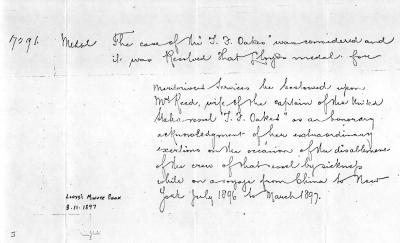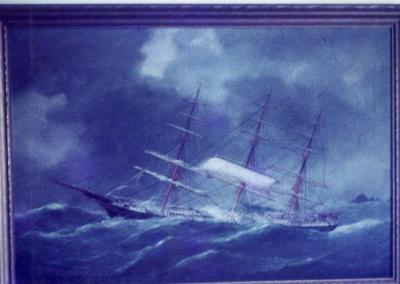The T.F. Oake’s 1896-97 voyage from Hong Kong to New York harbor had been hard.
Unfavorable winds challenged the crew, and with food rationing, illness broke out among the men, leading to the death of the Chinese cook on November 11. In quick succession, five more sailors were buried at sea. The remaining crew, not including the first mate, Captain Reed and his wife, Mary, fell desperately ill with scurvy, too weak to move from their bunks.
The singular bright spot during the bleak voyage was Mary Reed’s bravery. Described as “a woman of masculine proportions”, her husband proudly called her “the best man aboard ship”. During a terrific March 1, 1897 gale, and when the Oakes was off Cape Hatteras, it was Mary Reed who singlehandedly took over the ship’s wheel, attending to the halyards and the sheets.
(Mary Reed’s heroism did not go unnoticed–Lloyd’s of London, the vessel’s insurer, awarded her a special commendation).
A few days after the Oakes limped into New York harbor, her surviving sailors filed charges against Captain Reed in U.S. District Court, claiming he willfully withheld food. At the trial, the sailors testified to his cruelty and their near starvation. The jury found Reed not guilty. Citing precedent for their decision, the jury noted it was an unusual voyage, and not unexpected that men fell ill. In a related civil lawsuit, the crew pressed charges against Reed for neglect and that he had not supplied sufficient food–a New York judge awarded the plaintiffs $2,914.
During litigation, the T.F. Oakes was sold to Lewis Luckenbach. Concerned about sailor’s reluctance to work on a ship with a shady past, her name was changed to the New York and the popular Thomas Peabody hired to captain her.
The New York’s maiden voyage form New York to Asia and San Francisco commenced on May 18, 1897. On board the ship loaded with oil were Captain Peabody’s wife, Clara, and their seven-year-old daughter Claire. Peabody brought along hs optimism: “New captain, new name, we shall be lucky,” he said.
Crew members included the tall, thin, quiet first mate, Callip, and San Mateo County resident Paul Scharrenberg, an “industrious, brown-haired, blue-eyed lad”–later director of the California State Department of Industrial Relations.
The New York plowed through the Java and China Seas and after nine months in deep water, sailed up the Whangpoo River, dropping anchor at Shanghai, where they sampled the teeming city by rickshaw, before returning to Hong Kong.
During the month-long stay in Hong Kong, bird shops fascinated young Claire, where caged monkeys jumped up and down to attract attention. On a shopping spree, Claire’s mother bought a pure white, screeching parrot with a pale green topknot. The parrot was now a part of the New York’s crew.
Preparing to sail for San Francisco, coolies loaded porcelain, silks, rice, wine, tea, peanuts, teakwood chairs and firecrackers aboard the ship. “Bright with Chinese characters”, the cargo boxes smelled of incense and spices.
On January 14, 1898, the New York sailed out of Hong Kong harbor, but “from the first day we left China unil we sighted the California coast we had a miserable time,” wrote Claire Peabody in her book, “Singing Sails” (1950).
Non-stop storms pushed and pulled the vessel. Protected by waterproofed oilskins, Captain Peabody gave orders to the crew, a crew that whispered that the New York was a doomed ship. They feared they would never see San Francisco.
Worse, the First Mate, Callip, fell ill with a “cold” that didnt’ improve; the Captain stood his watch.
Surrounded and battered by rough weather around Cape Horn, little Claire Peabody continued her on-board education, memorizing Henry Wadsworth Longfellow’s poems.
When the ship was 850 miles west of San Francisco, the crew encountered a gale so terrible that it “snared the iron ship in its teeth”. The New York rolled around helplessly in tremendous seas, often in danger of foundering.
(Document below: Lloyds of London awarded Mary Reed a medal for her courage. Click to enlarge)
Top: Painting of the T.F. Oakes by Mary Reed, who was also known as Hannah.
…To be continued…

